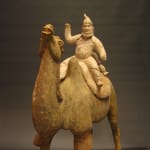Early Tang Painted Pottery Walking Camel with Detachable Rider, 618 CE - 907 CE
Terracotta
47 x 55.9 cm
18 1/2 x 22 in
18 1/2 x 22 in
DL.2073
Further images
The camel is an unusual domestic animal; it carries a saddle of flesh on its back; swiftly it dashes over the shifting sands; it manifests its merit in dangerous places;...
The camel is an unusual domestic animal; it carries a saddle of flesh on its back; swiftly it dashes over the shifting sands; it manifests its merit in dangerous places; it has a secret understanding of springs and sources, subtle indeed is its knowledge.'
--Guo Pu, 3rd Century A
For the Chinese, camels symbolized commerce and its associated wealth, largely concentrated on profits though trading on the Silk Road. Trade across this extensive network of paths and trails brought prosperity, foreign merchants, and exotic merchandize into China. However, the dusty trails of the Silk Road were an arduous journey through the rugged mountains and harsh desert of Central Asia that could only be traversed by the two humped Bactrian camel. This remarkable beast was able to withstand the scorching heat of the desert and maintain its own nutrients, surviving for months without fresh supplies of water. The government kept vast herds of these invaluable creatures, presided over by civil officials, for hauling their precious commodities across the Silk Road. These exotic creatures were a common sight in the cosmopolitan cities of Tang China, carrying both traders and their goods directly into the markets. Likewise, Tang artists began to create charming representations of these prized creatures as mingqi in order to symbolize wealth and prosperity in the afterlife.
Mingqi were works of art specifically created in an ancient Chinese custom for interment in the tombs of elite individuals in order to provide for their afterlife. Some of the most beautiful works of Chinese art were excavated from such tombs, and this sculpture of a camel and detachable rider is a perfect example of the refined artistry dedicated to such works despite the fact that they were never meant to be seen by the living. The distinct physiognomy of the rider reveals that he is of foreign descent, most likely a Turkic merchant from Central Asia. We can imagine him guiding a caravan into the cities of Tang China, carrying his precious goods directly into the market. Traces of polychromy survive on both the camel and the rider. The animal’s head is raised, teeth visible in its open mouth, perhaps in protest at its long journey. The hairs on its neck are expertly modelled as are the details of the rider’s clothing. He wears boots and a peaked cap and sports a full beard. He probably held a whip of some kind in his left hand which has since been lost. This sculpture reveals the Tang Dynasty’s respect and admiration for this beast of burden, so essential to the prosperity of ancient China.
--Guo Pu, 3rd Century A
For the Chinese, camels symbolized commerce and its associated wealth, largely concentrated on profits though trading on the Silk Road. Trade across this extensive network of paths and trails brought prosperity, foreign merchants, and exotic merchandize into China. However, the dusty trails of the Silk Road were an arduous journey through the rugged mountains and harsh desert of Central Asia that could only be traversed by the two humped Bactrian camel. This remarkable beast was able to withstand the scorching heat of the desert and maintain its own nutrients, surviving for months without fresh supplies of water. The government kept vast herds of these invaluable creatures, presided over by civil officials, for hauling their precious commodities across the Silk Road. These exotic creatures were a common sight in the cosmopolitan cities of Tang China, carrying both traders and their goods directly into the markets. Likewise, Tang artists began to create charming representations of these prized creatures as mingqi in order to symbolize wealth and prosperity in the afterlife.
Mingqi were works of art specifically created in an ancient Chinese custom for interment in the tombs of elite individuals in order to provide for their afterlife. Some of the most beautiful works of Chinese art were excavated from such tombs, and this sculpture of a camel and detachable rider is a perfect example of the refined artistry dedicated to such works despite the fact that they were never meant to be seen by the living. The distinct physiognomy of the rider reveals that he is of foreign descent, most likely a Turkic merchant from Central Asia. We can imagine him guiding a caravan into the cities of Tang China, carrying his precious goods directly into the market. Traces of polychromy survive on both the camel and the rider. The animal’s head is raised, teeth visible in its open mouth, perhaps in protest at its long journey. The hairs on its neck are expertly modelled as are the details of the rider’s clothing. He wears boots and a peaked cap and sports a full beard. He probably held a whip of some kind in his left hand which has since been lost. This sculpture reveals the Tang Dynasty’s respect and admiration for this beast of burden, so essential to the prosperity of ancient China.









